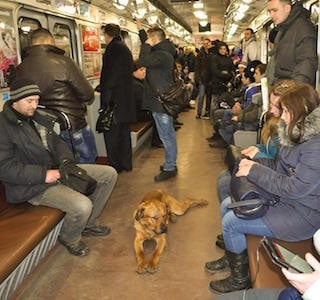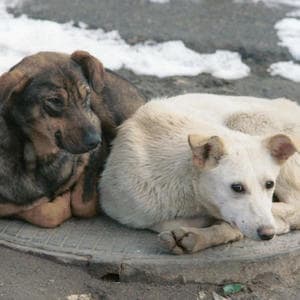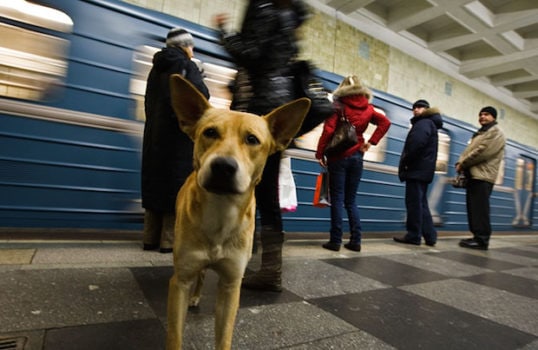The streets of Moscow are flooded with upwards of 35,000 stray dogs. While most of them are wild and shy away from human contact, some have found that the best way to survive is to be amongst the city’s bustling population. These dogs have figured out where exactly they need to be in order to better their chances of survival – passing by office buildings during lunch hour might enable them to score a tossed out sandwich scrap and when places of business shut down, they head where the people head – near their homes and apartments.
Some of these clever homeless dogs have taken it a step further, learning that the best way to get from A to B in the shortest amount of time is to hop on the city’s public transit system. Yes, these dogs ride the subway!
Street Dogs on the Subway
According to Dr. Jacqueline Boyd, a lecturer in animal science at Nottingham Trent University, it’s extremely common for feral dogs to seek shelter in the below-ground subway tunnels, but a small percentage of the city’s strays have become underground rail system regulars. This group of homeless pups uses the subway system to move from one area to the next and are even known to have stops that they implement into their daily survival routines.
In addition to the ease of navigating through the infrastructure, these intelligent canines head to the subways to escape the crowded city streets and inclimate weather. They often scavenge the train cars for leftover food and are right there when someone drops a pretzel or a piece of a sandwich falls from someone’s lap.

These dogs have developed a keen sense of time and are able to calculate when to get on and off the subway in order to reach their desired locations. In addition, scientists have noticed that the stray dogs in Russia will typically jump on the first or last metro car – the ones that are usually the least crowded. The dogs have also figured out that they need to leap on and off of the subway cars before the doors shut so as not to get their tails stuck.
Moscow’s Stray Dog Problem
Jelena Nosireva, a volunteer with Kozhuhovo’s Municipal Shelter, says the problem of the increasing population of wild dogs in Moscow dates back to the USSR when it was normal to toss an unwanted dog out onto the street.
“Nobody ever controlled the process, no one ever heard about human attitude towards stray animals, and no one was interested in creating decent conditions for their living,” she says.
Over the years, the problem snowballed, as did the population of stray dogs roaming the streets and subway systems. Natalia Bystrova of PetFund, a Russian animal advocacy organization, adds that there doesn’t seem to be a quick solution to the issue. There are currently no city laws that protect animals – “people can abandon, lose, mistreat their animal, make them produce puppies, and then abandon those puppies or kill them,” she says.
There are no regulations on governmental level to control these processes, in addition, city does not supply bins for dog poop and many pet owners fail to clean up after their pets, she says.
“Neutering and spaying pets is highly unpopular as people see it as opposed to nature and very unhealthy for their pets,” Bystrova adds. So the population of stays continues to grow and overflowing trash bins provide food for the animals, who then multiply on the city streets and infiltrate the metro systems for safety.
Dogs on Russian subways have become so common that passengers don’t think twice about glancing over and seeing a four-legged commuter lying on the floor hitching a ride. In fact, some dogs are bold enough to jump up on a seat bench and stretch out across the row. They’ll even cram right in between human passengers and curl up on an empty seat.

“They never show aggression towards people. They are so unhappy and lonely,” Nosireva says. “They seek any help looking into people’s eyes, asking for some food.”
She adds that some of her fellow volunteers make a habit out of luring these dogs off the streets and trying to find them good homes. But even that isn’t always a promising solution.
The Future of Strays in Moscow
Animal rescue shelters like Kozhuhovo are working to get as many dogs off the streets as possible. But, as Bystrova points out, the process of finding these canines a forever home is far from easy.
“Adopting strays is very unpopular in Russia,” she says. “Mix-breed dogs are seen as low-class pets, only for people who cannot afford a purebred dog or cat.”
In fact, strays are looked down upon so much that people often toss stones at them or kick them when they cross paths with them on the streets.
Most animal shelter conditions are just as dismal. Dogs picked up off the street often spend their days in dirty cages without heat or air conditioning and sometimes without daily access to water. Rescue facilities like Kozhuhovo, however, are doing their best to combat that. The organization is working to compassionately care for stray animals and to teach the citizens of Moscow to be merciful to these unfortunate dogs.
“Only by showing human attitude towards stray animals, taking them home from the streets and from the shelters, and giving them our love and care can things change,” says Nosireva. “And we really hope that they do.”
Until then, we have to applaud Moscow’s wild dogs in their ability to network the city’s overwhelming population and brutal winters to find food and shelter.

Nicole Pajer is a freelance writer who lives in Los Angeles with her husband, energetic Doberman, and rat terrier.
Share:









